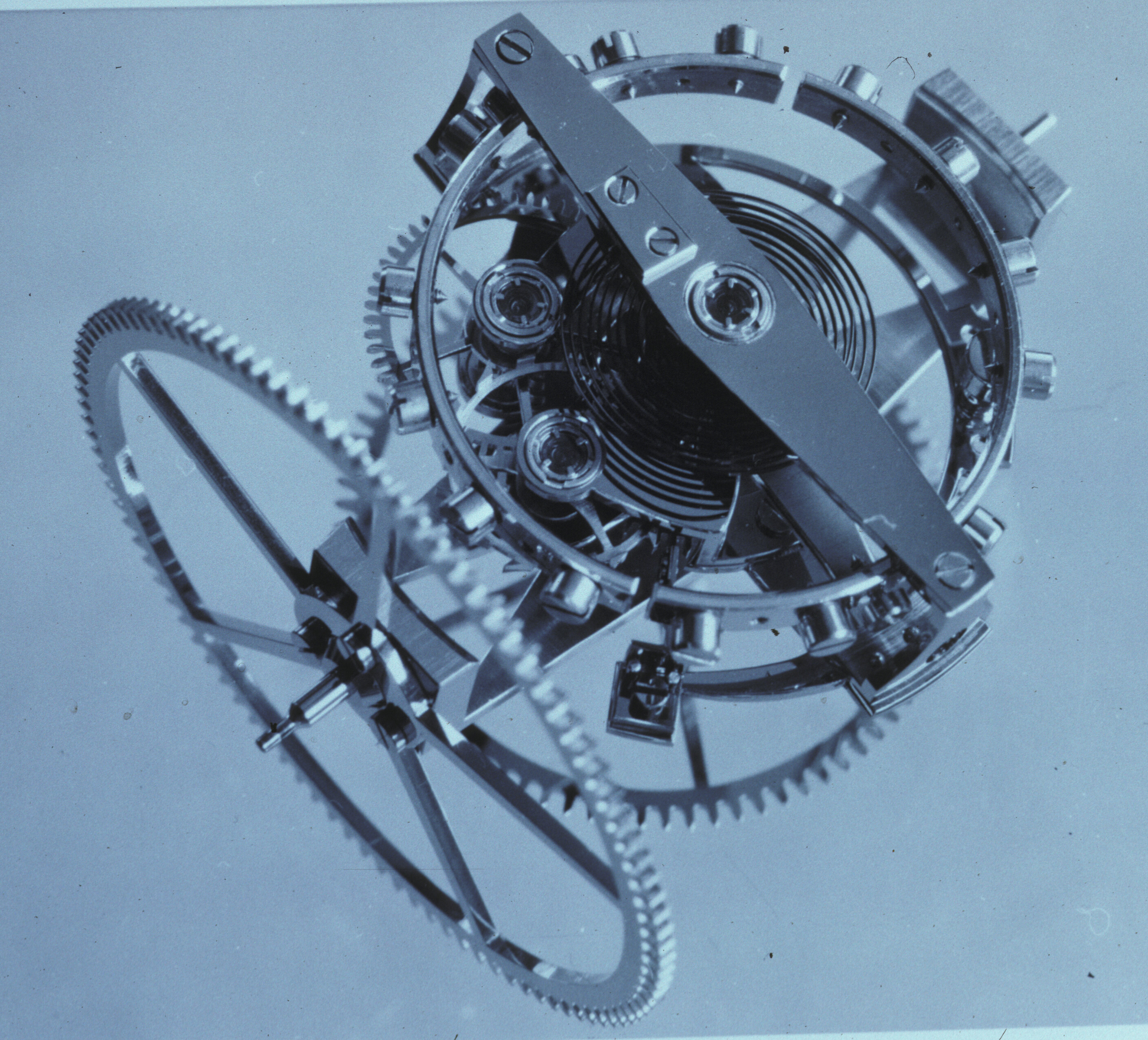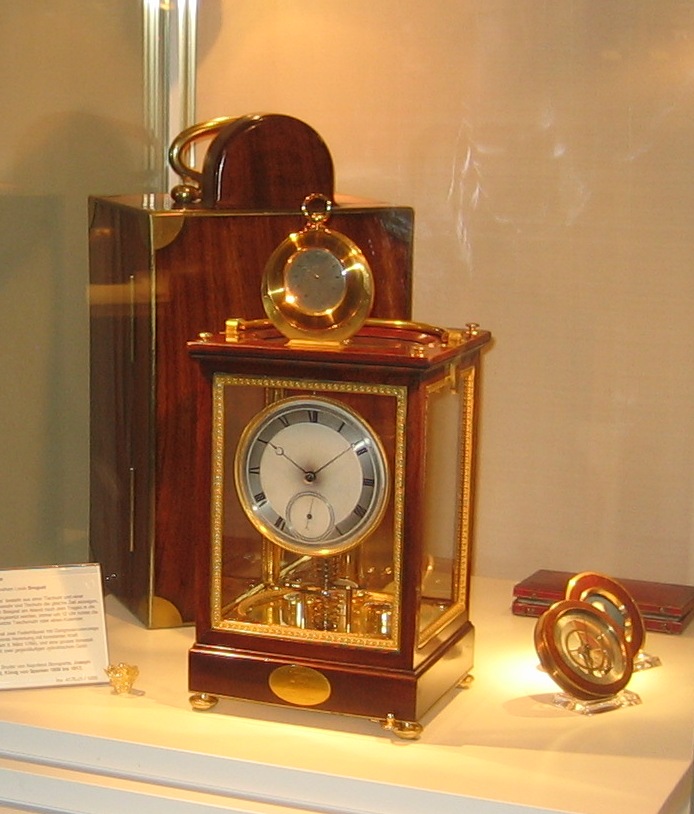|
Tourbillon
In horology, a tourbillon (; " whirlwind") is an addition to the mechanics of a watch escapement to increase accuracy. It was developed around 1795 and patented by the Swiss-French watchmaker Abraham-Louis Breguet on June 26, 1801. In a tourbillon the escapement and balance wheel are mounted in a rotating cage, with the goal of eliminating errors of poise in the balance giving a uniform weight. Tourbillons are still included in some modern wristwatches, the mechanism is usually exposed on the watch's face to showcase it. Types of tourbillon Single axis tourbillon Patented by Breguet in 1801, the single axis tourbillon minimizes the difference in rate between positions caused by poise errors. The tourbillon was invented to complement the split bi-metallic balance which was inherently difficult to poise. In the most common implementation of this, the tourbillon carriage is carried by the fourth pinion, within a stationary fourth wheel. The escape pinion is engaged with thi ... [...More Info...] [...Related Items...] OR: [Wikipedia] [Google] [Baidu] |
Greubel Forsey
Greubel Forsey is a Swiss watchmaking company specializing in complicated, high-end timepieces. It was launched in 2004 by Robert Greubel and Stephen Forsey and is based in La Chaux-de-Fonds, Switzerland. Greubel Forsey makes timepieces with multiple tourbillons and inclined balance wheels with the aim of improving timekeeping precision. Corporate history Robert Greubel and Stephen Forsey launched Greubel ForseyHistory of Greubel Forsey HauteHorologer.org in 2004 at with the introduction of their ''Double Tourbillon 30° (DT30)''. Both men had been working together since 1992 at Renaud & Papi, where they developed complicated watch movements. In 1999 Greubel and Forsey b ... [...More Info...] [...Related Items...] OR: [Wikipedia] [Google] [Baidu] |
Jaeger-LeCoultre
Manufacture Jaeger-LeCoultre SA, or simply Jaeger-LeCoultre (), is a Swiss luxury watch and clock manufacturer founded by Antoine LeCoultre in 1833 and is based in Le Sentier, Switzerland. Since 2000, the company has been a fully owned subsidiary of the Swiss luxury group Richemont. Jaeger-LeCoultre is regarded as a top-tier Richemont brand. It has hundreds of inventions, patents, and more than one thousand movements to its name, including the world's smallest movement, one of the world's most complicated wristwatches (Grande Complication), and a timepiece of near-perpetual movement (the '' Atmos clock''). History Early history The earliest records of the LeCoultre family in Switzerland date from the 16th century, when Pierre LeCoultre (circa 1530 – circa 1600), a French Huguenot, fled to Geneva from Lizy-sur-Ourcq, France to escape religious persecution. In 1558, he obtained the status of “inhabitant” but left the following year to acquire a plot of land in the Va ... [...More Info...] [...Related Items...] OR: [Wikipedia] [Google] [Baidu] |
Abraham-Louis Breguet
Abraham-Louis Breguet (10 January 1747 – 17 September 1823), born in Neuchâtel, then a Prussian principality, was a horologist who made many innovations in the course of a career in watchmaking industry. He was the founder of the Breguet company, which is now the luxury watch division of the Swiss Swatch Group. In his lifetime he was considered the leading watchmaker of his day, and he built up a clientele that included many leading public figures and members of the European nobility. Alongside his friend and contemporary John Arnold, Breguet is now widely acknowledged as one of the greatest horologists of all time. One of his famous ancestors was Jean Breguet (who died in 1593) a Protestant pastor in Neuchâtel very much influenced by the ideas of John Calvin. Life Breguet was born in Neuchâtel to Jonas-Louis Breguet and Suzanne-Marguerite Bolle. Breguet's father died in 1758 when he was ten, and his formal schooling ended when he was 12. Breguet's mother remarr ... [...More Info...] [...Related Items...] OR: [Wikipedia] [Google] [Baidu] |
Breguet (brand)
Breguet is a Swiss- French luxury watch, clock and jewelry manufacturer founded by Abraham-Louis Breguet in Paris in 1775. Since 1999, it has been a subsidiary of the Swiss Swatch Group. Headquartered in L'Abbaye, Switzerland, Breguet is one of the oldest surviving watchmaking brands and a pioneer of numerous watchmaking technologies such as the tourbillon, which was invented by Abraham Breguet in 1801. Abraham Breguet also invented and produced the world's first self-winding watch (the ''Perpétuelle'') in 1780, as well as the world's first wristwatch in 1810 (the Breguet No.2639, for Caroline Bonaparte, Queen of Naples). Breguet is a highly regarded watch manufacturer. Over the years, notable Breguet patrons and timepieces owners include King George III, Queen Victoria, Alexandre I of Russia, Napoléon Bonaparte, Ettore Bugatti, Sir Winston Churchill, Sergei Rachmaninoff, Gioachino Rossini, Arthur Rubinstein and so on. In particular, the ''Breguet & Fils, Paris No. 2667 (1814 ... [...More Info...] [...Related Items...] OR: [Wikipedia] [Google] [Baidu] |
Girard-Perregaux
Girard-Perregaux SA () is a luxury Swiss watch ''manufacture'' with its origins dating back to 1791. Since 2011, the Swiss holding group of Girard-Perregaux, Sowind Group, has been a subsidiary of the French luxury group Kering. Headquartered in La Chaux-de-Fonds, Switzerland, the company opened the Girard-Perregaux Museum near its headquarters in Villa Marguerite in 1999. It is best known for the historic Tourbillon with three gold bridges, which was awarded a gold medal at the 1889 International Exposition in Paris soon after the launch of the watch. Other notable models from the company include the collection 1966, Vintage 1945, and models such as Tri-Axial Tourbillon and Laureato, an icon inspired from the 70s. History Early history In 1791, watchmaker and goldsmith Jean-François Bautte signed his first watches. He created a manufacturing company in Geneva, grouping for the first time ever all the watchmaking facets of that time. This included the engineering of the ... [...More Info...] [...Related Items...] OR: [Wikipedia] [Google] [Baidu] |
Mechanical Watch
A mechanical watch is a watch that uses a clockwork mechanism to measure the passage of time, as opposed to quartz watches which function using the vibration modes of a piezoelectric quartz tuning fork, or radio watches, which are quartz watches synchronized to an atomic clock via radio waves. A mechanical watch is driven by a mainspring which must be wound either periodically by hand or via a self-winding mechanism. Its force is transmitted through a series of gears to power the balance wheel, a weighted wheel which oscillates back and forth at a constant rate. A device called an escapement releases the watch's wheels to move forward a small amount with each swing of the balance wheel, moving the watch's hands forward at a constant rate. The escapement is what makes the 'ticking' sound which is heard in an operating mechanical watch. Mechanical watches evolved in Europe in the 17th century from spring powered clocks, which appeared in the 15th century. Mechanical watches are ... [...More Info...] [...Related Items...] OR: [Wikipedia] [Google] [Baidu] |
Escapement
An escapement is a mechanical linkage in mechanical watches and clocks that gives impulses to the timekeeping element and periodically releases the gear train to move forward, advancing the clock's hands. The impulse action transfers energy to the clock's timekeeping element (usually a pendulum or balance wheel) to replace the energy lost to friction during its cycle and keep the timekeeper oscillating. The escapement is driven by force from a coiled spring (device), spring or a suspended weight, transmitted through the timepiece's gear train. Each swing of the pendulum or balance wheel releases a tooth of the escapement's ''escape wheel'', allowing the clock's gear train to advance or "escape" by a fixed amount. This regular periodic advancement moves the clock's hands forward at a steady rate. At the same time, the tooth gives the timekeeping element a push, before another tooth catches on the escapement's pallet, returning the escapement to its "locked" state. The sudden st ... [...More Info...] [...Related Items...] OR: [Wikipedia] [Google] [Baidu] |
Quartz
Quartz is a hard, crystalline mineral composed of silica ( silicon dioxide). The atoms are linked in a continuous framework of SiO4 silicon-oxygen tetrahedra, with each oxygen being shared between two tetrahedra, giving an overall chemical formula of SiO2. Quartz is the second most abundant mineral in Earth's continental crust, behind feldspar. Quartz exists in two forms, the normal α-quartz and the high-temperature β-quartz, both of which are chiral. The transformation from α-quartz to β-quartz takes place abruptly at . Since the transformation is accompanied by a significant change in volume, it can easily induce microfracturing of ceramics or rocks passing through this temperature threshold. There are many different varieties of quartz, several of which are classified as gemstones. Since antiquity, varieties of quartz have been the most commonly used minerals in the making of jewelry and hardstone carvings, especially in Eurasia. Quartz is the mineral definin ... [...More Info...] [...Related Items...] OR: [Wikipedia] [Google] [Baidu] |
Quartz Watch
Quartz is a hard, crystalline mineral composed of silica (silicon dioxide). The atoms are linked in a continuous framework of SiO4 silicon-oxygen tetrahedra, with each oxygen being shared between two tetrahedra, giving an overall chemical formula of SiO2. Quartz is the second most abundant mineral in Earth's continental crust, behind feldspar. Quartz exists in two forms, the normal α-quartz and the high-temperature β-quartz, both of which are chiral. The transformation from α-quartz to β-quartz takes place abruptly at . Since the transformation is accompanied by a significant change in volume, it can easily induce microfracturing of ceramics or rocks passing through this temperature threshold. There are many different varieties of quartz, several of which are classified as gemstones. Since antiquity, varieties of quartz have been the most commonly used minerals in the making of jewelry and hardstone carvings, especially in Eurasia. Quartz is the mineral defining the val ... [...More Info...] [...Related Items...] OR: [Wikipedia] [Google] [Baidu] |
Euro
The euro (symbol: €; code: EUR) is the official currency of 19 out of the member states of the European Union (EU). This group of states is known as the eurozone or, officially, the euro area, and includes about 340 million citizens . The euro is divided into 100 cents. The currency is also used officially by the institutions of the European Union, by four European microstates that are not EU members, the British Overseas Territory of Akrotiri and Dhekelia, as well as unilaterally by Montenegro and Kosovo. Outside Europe, a number of special territories of EU members also use the euro as their currency. Additionally, over 200 million people worldwide use currencies pegged to the euro. As of 2013, the euro is the second-largest reserve currency as well as the second-most traded currency in the world after the United States dollar. , with more than €1.3 trillion in circulation, the euro has one of the highest combined values of banknotes and coins in c ... [...More Info...] [...Related Items...] OR: [Wikipedia] [Google] [Baidu] |









